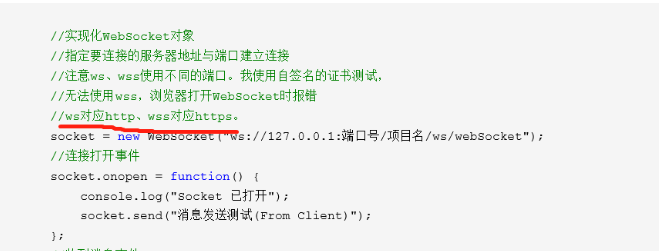介绍
WebSocket是HTML5开始提供的一种在单个 TCP 连接上进行全双工通讯的协议。在WebSocket API中,浏览器和服务器只需要完成一次握手,两者之间就直接可以创建持久性的连接,并进行双向数据传输。WebSocket使用和 HTTP 相同的 TCP 端口,可以绕过大多数防火墙的限制。默认情况下,WebSocket协议使用80端口;运行在TLS之上时,默认使用443端口。
WebSocket协议建立连接的时候需要握手,握手过程中需要借助HTTP协议来完成,当连接建立后,就可以使用WebSocket协议进行通信,通信结束后,通信双方都可以关闭连接。
API文档:https://developer.mozilla.org/zh-CN/docs/Web/API/WebSocket
前端:
1、新建服务器的连接:var webSocket = new WebSocket(url); 2、初始化回调函数 ex:webSocket.onmessage = function (event){ var data = event.data; console.log(“收到的消息”+data); }

3、发送消息给服务器
webSocket.send(message);
后端:
- 配置pom文件
<!-- 引入 websocket 依赖类-->
<dependency>
<groupId>org.springframework.boot</groupId>
<artifactId>spring-boot-starter-websocket</artifactId>
</dependency>
开启WebSocket服务端的自动注册
注意:ServerEndpointExporter 是由Spring官方提供的标准实现,用于扫描ServerEndpointConfig配置类和@ServerEndpoint注解实例。使用规则也很简单:1.如果使用默认的嵌入式容器 比如Tomcat 则必须手工在上下文提供ServerEndpointExporter。2. 如果使用外部容器部署war包,则不要提供提供ServerEndpointExporter,因为此时SpringBoot默认将扫描服务端的行为交给外部容器处理
/** * 开启WebSocket支持 */ @Configuration public class WebSocketConfig { @Bean public ServerEndpointExporter serverEndpointExporter() { return new ServerEndpointExporter(); } }
- 创建WebSocket服务端
①通过注解@ServerEndpoint来声明实例化WebSocket服务端。(注意配置@Component才能被spring扫描)
② 通过注解@OnOpen、@OnMessage、@OnClose、@OnError 来声明回调函数。

③发送消息:new Session().getBasicRemote().sendText(message);
- WebSocket服务类编写
这里对照下面的代码看:
- 第20行,@ServerEndpoint("/websocket/{userID}"),括号中的内容就是客户端请求Socket连接时的访问路径,userID是我要求客户端传来的参数,我这里算是为了标识该客户端吧。
- 第28行,在该类中添加属性 userID,并添加对应的getUserID()方法。
- 第46行,在onOpen()方法即建立连接的时候就接收参数userID,需要标识@PathParam("userID") 。接收参数后直接赋值给属性userID。
- 第140-157行,是针对特定客户端发送消息。服务器和客户端在建立连接成功后就生成了一个WebSocket对象,并存在集合中,对象里特有的属性是我们设置的userID。所以通过唯一的userID就能标识服务器与该客户端建立的那个连接啦!这样要求发送消息时,传入userID与消息,服务器在自己的WebSocket连接集合中遍历找到对应客户端的连接,就可以直接发消息过去啦~~
package com.cuc.happyseat.websocket; import java.io.IOException; import java.util.concurrent.CopyOnWriteArraySet; import javax.websocket.EncodeException; import javax.websocket.OnClose; import javax.websocket.OnError; import javax.websocket.OnMessage; import javax.websocket.OnOpen; import javax.websocket.Session; import javax.websocket.server.PathParam; import javax.websocket.server.ServerEndpoint; import org.springframework.stereotype.Component; /*@ServerEndpoint注解是一个类层次的注解,它的功能主要是将目前的类定义成一个websocket服务器端, * 注解的值将被用于监听用户连接的终端访问URL地址,客户端可以通过这个URL来连接到WebSocket服务器端 */ @ServerEndpoint("/websocket/{userID}") @Component public class WebSocketServer { //每个客户端都会有相应的session,服务端可以发送相关消息 private Session session; //接收userID private Integer userID; //J.U.C包下线程安全的类,主要用来存放每个客户端对应的webSocket连接 private static CopyOnWriteArraySet<WebSocketServer> copyOnWriteArraySet = new CopyOnWriteArraySet<WebSocketServer>(); public Integer getUserID() { return userID; } /** * @Name:onOpen * @Description:打开连接。进入页面后会自动发请求到此进行连接 * @Author:mYunYu * @Create Date:14:46 2018/11/15 * @Parameters:@PathParam("userID") Integer userID * @Return: */ @OnOpen public void onOpen(Session session, @PathParam("userID") Integer userID) { this.session = session; this.userID = userID; System.out.println(this.session.getId()); //System.out.println("userID:" + userID); copyOnWriteArraySet.add(this); System.out.println("websocket有新的连接, 总数:"+ copyOnWriteArraySet.size()); } /** * @Name:onClose * @Description:用户关闭页面,即关闭连接 * @Author:mYunYu * @Create Date:14:46 2018/11/15 * @Parameters: * @Return: */ @OnClose public void onClose() { copyOnWriteArraySet.remove(this); System.out.println("websocket连接断开, 总数:"+ copyOnWriteArraySet.size()); } /** * @Name:onMessage * @Description:测试客户端发送消息,测试是否联通 * @Author:mYunYu * @Create Date:14:46 2018/11/15 * @Parameters: * @Return: */ @OnMessage public void onMessage(String message) { System.out.println("websocket收到客户端发来的消息:"+message); } /** * @Name:onError * @Description:出现错误 * @Author:mYunYu * @Create Date:14:46 2018/11/15 * @Parameters: * @Return: */ @OnError public void onError(Session session, Throwable error) { System.out.println("发生错误:" + error.getMessage() + "; sessionId:" + session.getId()); error.printStackTrace(); } public void sendMessage(Object object){ //遍历客户端 for (WebSocketServer webSocket : copyOnWriteArraySet) { System.out.println("websocket广播消息:" + object.toString()); try { //服务器主动推送 webSocket.session.getBasicRemote().sendObject(object) ; } catch (Exception e) { e.printStackTrace(); } } } /** * @Name:sendMessage * @Description:用于发送给客户端消息(群发) * @Author:mYunYu * @Create Date:14:46 2018/11/15 * @Parameters: * @Return: */ public void sendMessage(String message) { //遍历客户端 for (WebSocketServer webSocket : copyOnWriteArraySet) { System.out.println("websocket广播消息:" + message); try { //服务器主动推送 webSocket.session.getBasicRemote().sendText(message); } catch (Exception e) { e.printStackTrace(); } } } /** * @throws Exception * @Name:sendMessage * @Description:用于发送给指定客户端消息 * @Author:mYunYu * @Create Date:14:47 2018/11/15 * @Parameters: * @Return: */ public void sendMessage(Integer userID, String message) throws Exception { Session session = null; WebSocketServer tempWebSocket = null; for (WebSocketServer webSocket : copyOnWriteArraySet) { if (webSocket.getUserID() == userID) { tempWebSocket = webSocket; session = webSocket.session; break; } } if (session != null) { //服务器主动推送 tempWebSocket.session.getBasicRemote().sendText(message); } else { System.out.println("没有找到你指定ID的会话:{}"+ "; userId:" + userID); } } }
- Controller类的编写。
- 我在看博客的时候,发现有的博主写了Controller类,有的没写,我就有点疑惑了。后来,咳咳,发现特地写了一个Controller类只是为了测试。。
- 一般在实际项目中,在确保建立连接过程没有问题的情况下,我们就直接在一些写好的接口中写 WebSocketServer.sendMessage(param, message)语句就行了。
- 也因此,你写的位置就决定了你什么时候给你的客户端发消息,这样也就实现了主动推送消息的功能咯~
前提是:在你的Controller类里,以@Resource的方式注入WebSocket,而不是@Autowired方式哦(⊙o⊙)。
@Resource WebSocketServer webSocket; @Autowired UserService userService; 调用示例: if(userID>0) { boolean location = userService.getLocation(userID); if(location==false) {//验证用户当前不在馆内 boolean i = userService.modifyLocation(userID, true); if(i==true) { modelMap.put("successEnter", true); //发消息给客户端 webSocket.sendMessage(userID, "success"); } }else { modelMap.put("successEnter", false); //发消息给客户端 webSocket.sendMessage(userID, "fail"); } }else { modelMap.put("successEnter", false); //发消息给客户端 webSocket.sendMessage(userID, "fail"); }
小程序是只支持https访问的,所以得用wss

嘿嘿嘿,下面是学习WebSocket过程中参考的几篇博文:
转载:https://www.cnblogs.com/codecheng/archive/2019/04/06/10657530.html